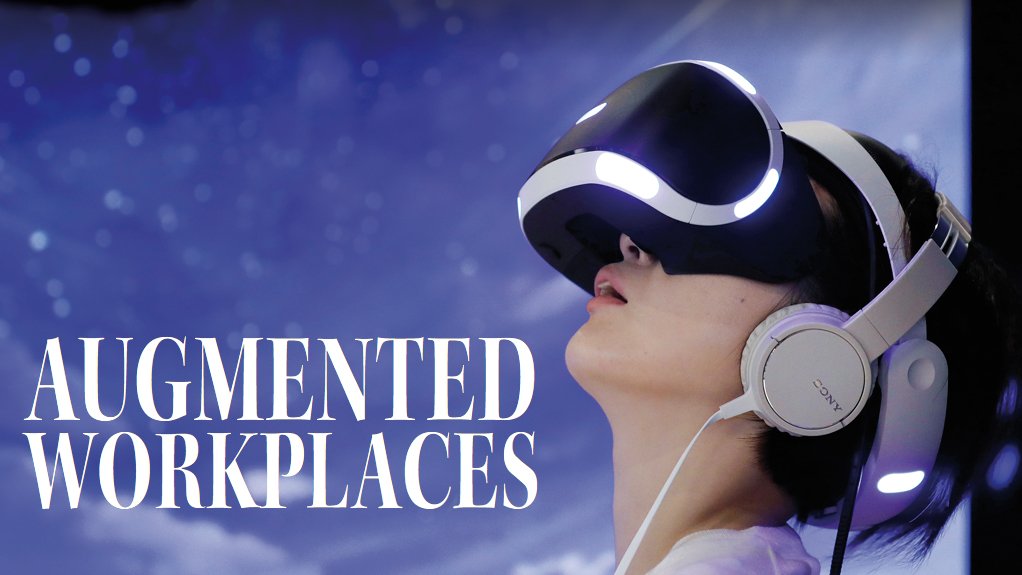Wearable tech starting to have a virtual and real impact on the workplace
While access control and health and safety wearable devices are commonplace in many commercial companies and industries, the use of augmented reality and virtual reality systems is expected to increase significantly over the next three to five years.
Augmented reality will enable employees to access contextual information feeds in real time using smart glasses while being able to use their hands. Virtual reality will mostly be used in control-room environments, where it will provide a way for staff to view detailed information about projects, monitor various aspects of work being carried out and plan operations and maintenance.
“There is burgeoning interest in the use of augmented reality by engineers to provide overlaying information and instructions when viewing complex equipment pieces and industrial systems,” says technology multinational BT Group customer innovation, energy, resources and automotive head Andy Rowland.
Wearables can help to close the skills gap – such as in the oil industry, where many experts must share their knowledge across various projects – and they will help to improve the diagnosis and resolution of faults in industries such as manufacturing, telecommunications, mining and oil and gas. Virtual reality training and augmented reality in the field can also increase the effectiveness of junior staff and assist them in executing tasks correctly at the first attempt, he says.
Further, smart glasses also improve productivity and safety. This is particularly useful in industrial scenarios, where wearing safety gloves or using both hands is required, and when it is not easy or safe to use a handheld device, adds digital security multinational Gemalto Internet of Things (IoT) and machine-to-machine solutions manager for Africa Mark Warren.
Gemalto is testing this technology at some of its factories, where an operator is assisted by a colleague in a different country, who shares relevant information and instructions to the glasses in real time, he adds.
WORKING WITH WEARABLES
“Every industry and every company will derive value from these systems based on their specific dynamics,” notes technology research firm World Wide Worx MD Arthur Goldstuck.
He says near-field communications and radio frequency identification tags and wristbands are commonplace for access-control purposes, and that the next stage of this technology is smart tracking for the management and coordination of personnel. The latter will entail more effective deployment of emergency services and police, coordinating their movements with traffic and incident reports.
Rowland states that some environments, such as call centres and warehouses, as well as personnel such as delivery drivers, are already heavily monitored. Wearables can potentially extend this capability and monitor many personnel safety, productivity and control aspects at industrial sites.
For wearables to be successful in the workplace, they need to form part of an environment that supports increased mobility and where multiple devices are used for well-defined purposes, Warren says.
Security is paramount for industrial systems and the objective is to ensure that digital identities assigned to individuals are stored securely in one wearable.
Wearables face the same cyberthreats as those encountered using mobile devices. Enterprises need to control which identities can access which data streams using strong authentication and apply this protection to all information technology (IT) resources – on premises, remotely and in the cloud, Warren says.
“Sensitive data must be encrypted at rest in storage, in motion as it is transmitted across the network, on premises and in the cloud. Strong key management should be used to secure encryption keys, which should be managed centrally.”
Wearables and IoT sensors will contribute to the number of cybersecurity weak points in years to come. Data leaks must be prevented and, though data on networks and the smartphones connected to those networks are currently protected, wearables connected to the smartphones are often not well protected, confirms Goldstuck.
“Similarly, badly secured sensors will offer a way into networks that depend on the data collected by the sensors. We have already seen denial of service attacks in which hijacked wearables and sensors have been used to launch attacks,” he adds.
A large retail chain was hacked using the access granted to service engineers to manage the air-conditioning systems in its stores, leading to millions of credit card details being stolen, while a cyberattack on a power station stemmed from the connections used by engineers. Engineers using virtual private network connections will continue to be targets for hackers, warns Rowland.
“For companies converging IT and operational technology, this is dangerous, and when you add large numbers of IoT devices, it becomes even more dangerous.”
Therefore, much tighter policies must be applied to manage the data, including the continuous monitoring of access to critical systems and what users are doing when accessing these systems.
“Unlike normal IT systems, you should assume low activity levels and report on specific activities, such as all failed log-ons and user addition followed by file download. Companies also need to ensure that the correct information is being streamed – as junior staff depend on the devices and information – to prevent a hacker streaming false instructions, which could cause damage to critical processes or infrastructure,” explains Rowland.
However, once secured, such an environment creates the opportunity for the same identity to be used for authentication across multiple devices in the enterprise, such as tablets and mobiles, including an employee’s personal device, highlights Warren.
The same wearables can then be used to gain physical access to buildings and logical access to encrypted communications or work processes and also help to secure payments. Wearables such as wristbands or smart watches are convenient form factors by nature; hence, their adoption will continue to increase.
APPLICATION AND ADOPTION
Wearables will become commonplace if people can communicate, travel, shop, bank, work and play, knowing that their unique digital identities are secure, Warren avers.
“Standalone devices that automatically address the needs in the health and security or personal identity arenas are ideal roles for wearables. For identity, in particular, using a wearable that stores your credentials in one device makes universal identity management more convenient to implement – to the benefit of users and enterprises,” he says.
“Wearable technology will accelerate the convergence of the digital and human worlds by bringing people into the IoT. While consumers are confident that wearable technology will help them interact with objects in their surroundings, they note that IoT technology may not necessarily be limited to wearables or mobile devices,” Ericsson ConsumerLab Consumer Insight expert Jasmeet Singh Sethi says.
About 60% of consumers surveyed in the ‘Ericsson ConsumerLab 2016’ report believe that ingestible pills and chips under the skin will be commonly used in the next five years to not only track vital health data but also provide access, authenticate transactions and identity, and control objects.
“Although consumers show the greatest interest in devices related to safety, we also see an openness to wearable technology beyond the current generation. In five years’ time, walking around with an ingestible sensor, which tracks your body temperature and adjusts the thermostat setting automatically once you arrive home, might be a reality,” Sethi says.
Wearables will initially be concentrated among middle- and upper-income groups, says Goldstuck. However, some uses, such as to support national medical services, will likely be funded by local authorities and care providers, states Rowland.
“One of the largest areas for growth of wearable devices is in the healthcare industry, specifically to monitor chronic conditions and high-risk patients.”
He highlights that organisations that make wearables available to customers will provide them with alternative channels. Customers will then have greater choice and the adoption and use of wearables will impact positively on customer experience and the subsequent commercial performance.
A big step forward for smart wearables will be when they do not rely on a paired smartphone for connectivity, Warren adds. As standalone devices become more prevalent, more commercial and consumer applications become possible. This trend will continue as 4G and 5G services make it easier for standalone wearables to transmit higher volumes of data quickly.
Ericsson notes that 33% of consumers expect to wear at least five wearable devices beyond 2020. Currently, safety- and security- related wearable devices are the most sought-after consumer wearables.
Ownership of wearables among smartphone users in the surveyed markets has doubled in the past year. A more diverse set of wearables, such as personal safety devices and smart garments, will go mainstream beyond 2020, when a booming market can be expected, concludes Sethi.
Comments
Announcements
What's On
Subscribe to improve your user experience...
Option 1 (equivalent of R125 a month):
Receive a weekly copy of Creamer Media's Engineering News & Mining Weekly magazine
(print copy for those in South Africa and e-magazine for those outside of South Africa)
Receive daily email newsletters
Access to full search results
Access archive of magazine back copies
Access to Projects in Progress
Access to ONE Research Report of your choice in PDF format
Option 2 (equivalent of R375 a month):
All benefits from Option 1
PLUS
Access to Creamer Media's Research Channel Africa for ALL Research Reports, in PDF format, on various industrial and mining sectors
including Electricity; Water; Energy Transition; Hydrogen; Roads, Rail and Ports; Coal; Gold; Platinum; Battery Metals; etc.
Already a subscriber?
Forgotten your password?
Receive weekly copy of Creamer Media's Engineering News & Mining Weekly magazine (print copy for those in South Africa and e-magazine for those outside of South Africa)
➕
Recieve daily email newsletters
➕
Access to full search results
➕
Access archive of magazine back copies
➕
Access to Projects in Progress
➕
Access to ONE Research Report of your choice in PDF format
RESEARCH CHANNEL AFRICA
R4500 (equivalent of R375 a month)
SUBSCRIBEAll benefits from Option 1
➕
Access to Creamer Media's Research Channel Africa for ALL Research Reports on various industrial and mining sectors, in PDF format, including on:
Electricity
➕
Water
➕
Energy Transition
➕
Hydrogen
➕
Roads, Rail and Ports
➕
Coal
➕
Gold
➕
Platinum
➕
Battery Metals
➕
etc.
Receive all benefits from Option 1 or Option 2 delivered to numerous people at your company
➕
Multiple User names and Passwords for simultaneous log-ins
➕
Intranet integration access to all in your organisation





















